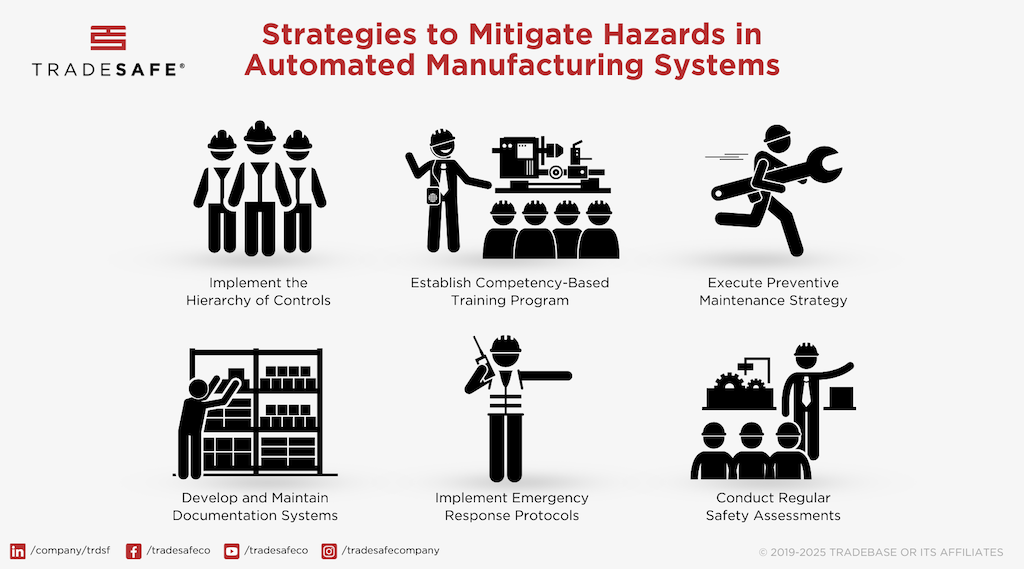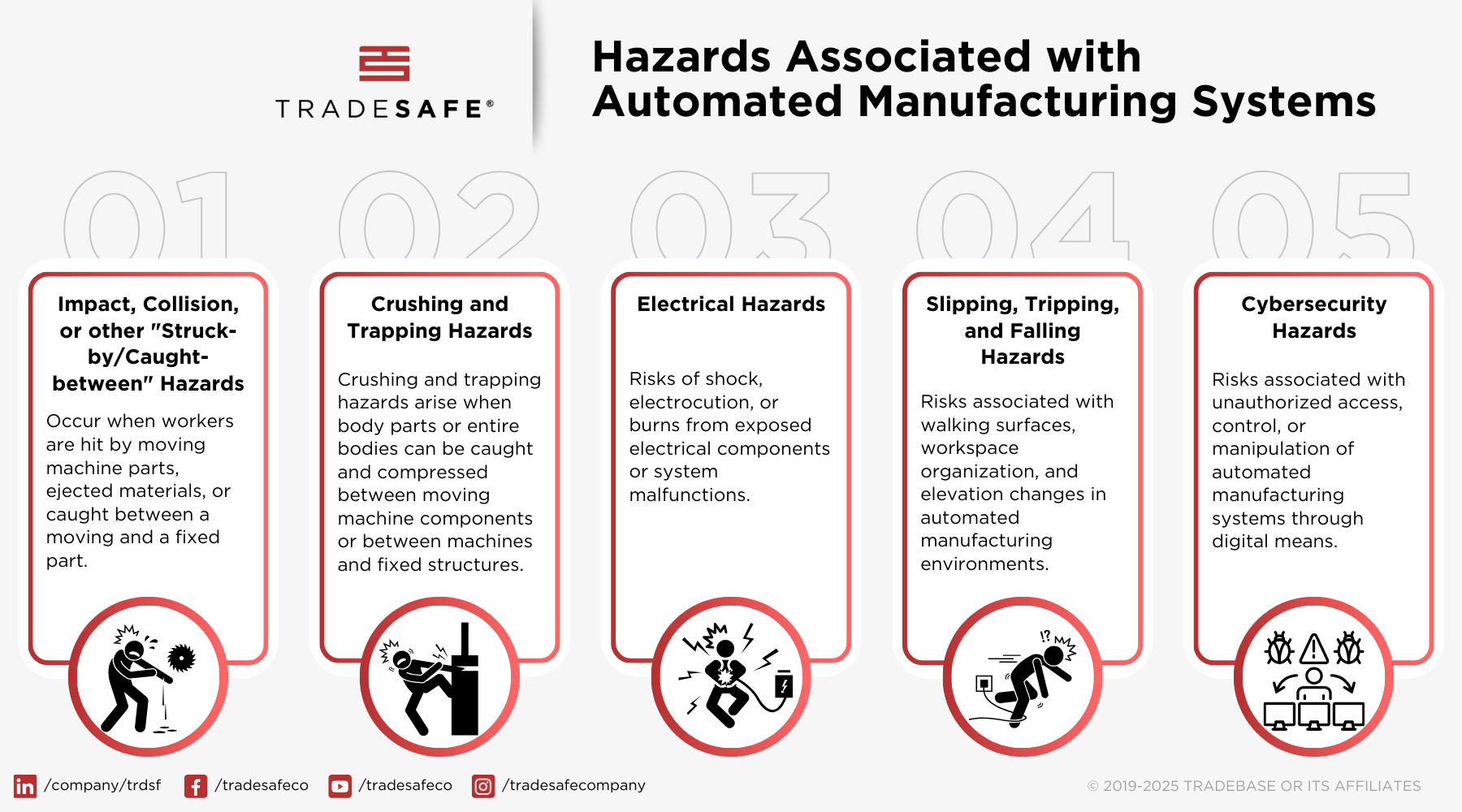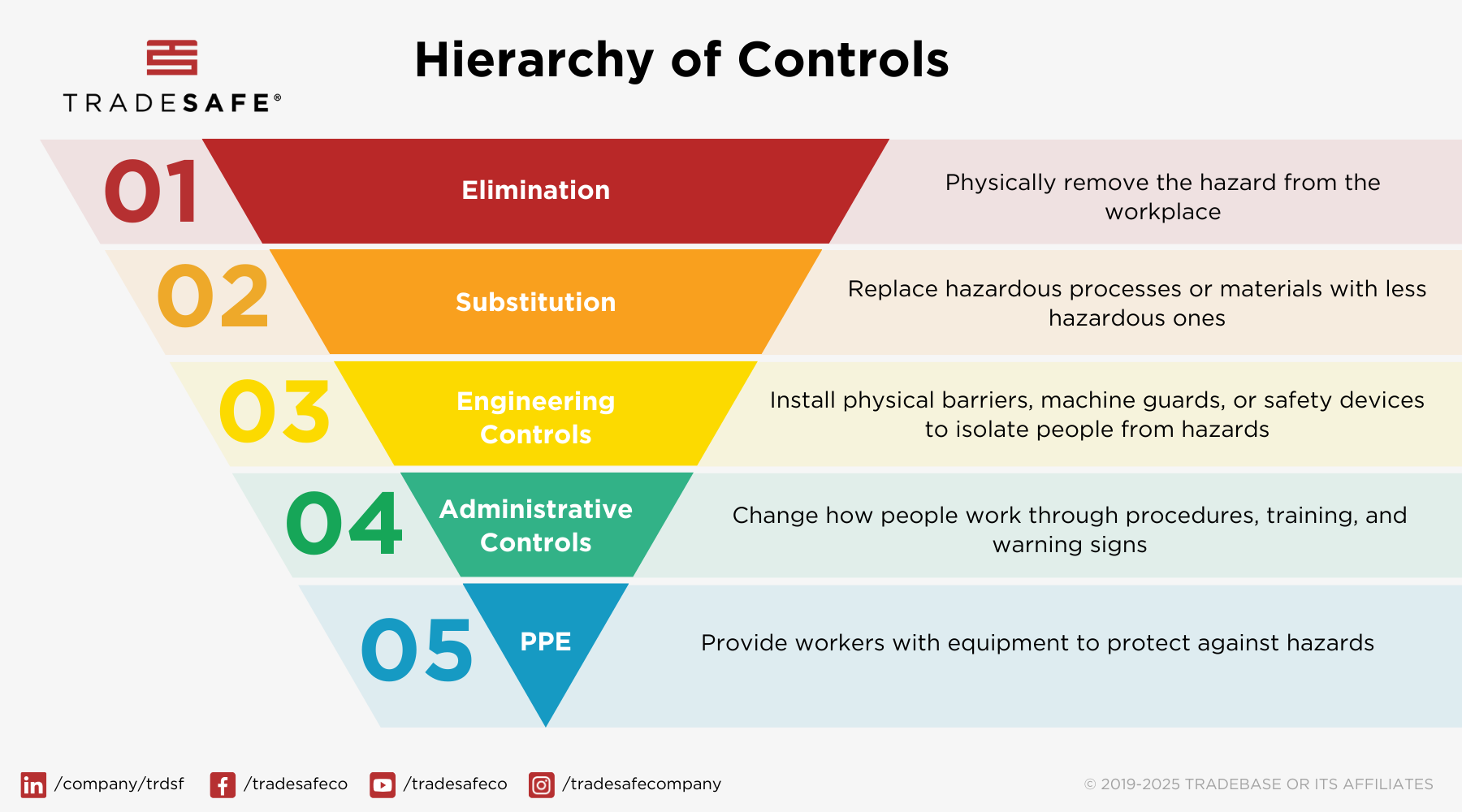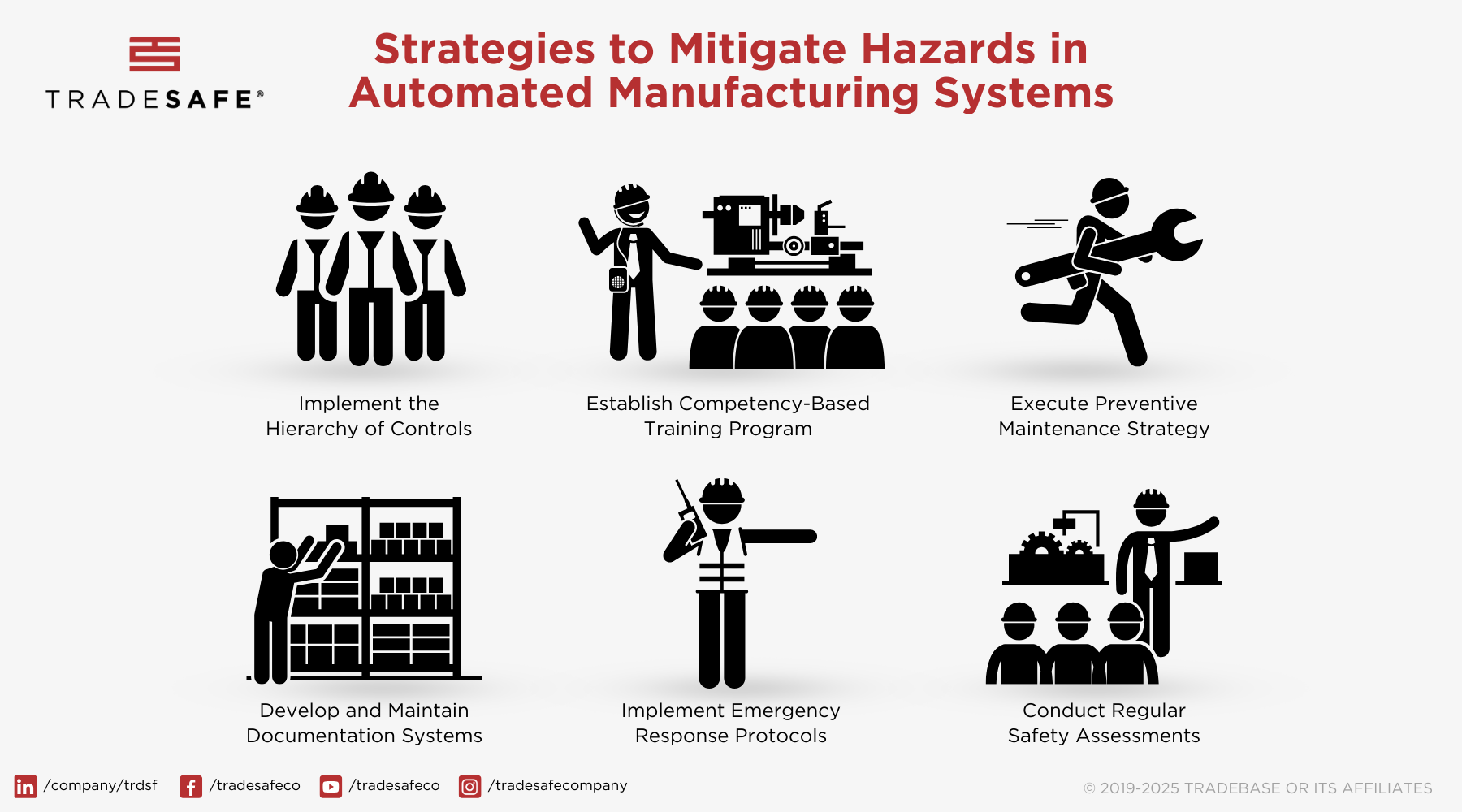While automation enhances productivity and safety, it also introduces unique hazards that must be effectively managed.

Learning Objectives
- Identify the specific hazards associated with automated manufacturing systems.
- Analyze the causes and potential impacts of these hazards on operations and personnel.
- Implement effective mitigation strategies and safety measures to minimize risks in automated environments.
Automated manufacturing systems insights
- Automated manufacturing systems can enhance a facility’s safety protocols.
- Workers and automated systems, including robots, create unique safety hazards. Potential risks include mechanical failures, software glitches and human-machine interaction issues that can lead to accidents or production downtime.
- Given these new hazards, manufacturers must develop protocols to protect workers.
Automation enhances productivity and safety, but it also introduces unique hazards that must be effectively managed. One such example occurred in June 2016 when a 20-year-old machine operator at a manufacturing facility lost her life. A robot unexpectedly reactivated while she and her colleagues were clearing a sensor fault. This tragic incident, resulting in more than $1.3 million in penalties and criminal charges, starkly illustrates the potentially devastating consequences of inadequate safety protocols in automated manufacturing environments.
Automated manufacturing systems are computer-controlled machines, equipment and processes that perform manufacturing operations with minimal human intervention. These systems integrate various technologies including robotics, programmable logic controllers (PLCs), sensors and computer-aided manufacturing software to execute precise, repetitive tasks. Automated manufacturing systems handle operations such as assembly, material handling, welding, painting and quality inspection, enabling manufacturers to achieve consistent quality and higher production rates.
These systems offer numerous benefits including increased productivity, improved product quality, reduced labor costs and enhanced workplace ergonomics by relieving workers from repetitive or physically demanding tasks. Additionally, modern automated systems can collect and analyze production data in real-time, allowing for predictive maintenance and continuous process optimization.
Despite these advantages, the complexity of automated manufacturing systems, combined with the high-speed operation of powerful machinery and the necessity for human-machine interaction, creates unique safety challenges that can result in serious injuries or fatalities when not properly addressed. As demonstrated by incidents like the one mentioned earlier, a simple system malfunction can have devastating consequences, making it critical to know the hazards in these systems and how to mitigate them.
Safety hazards associated with automated manufacturing systems
While there could be many safety challenges in automated manufacturing environments, especially those specific to different industries, we summed up the major ones with examples of how they could occur (see Figure 1).

Impact, collision or other struck-by or caught-between hazards: These hazards occur when workers are hit by moving machine parts, ejected materials or caught between a moving and a fixed part of automated equipment. In robotic assembly lines, for instance, a worker performing maintenance might be struck by an unexpected robotic arm movement if the system’s safety interlocks fail or proper lockout/tagout procedures aren’t followed. Similarly, automated guided vehicles in material handling operations can collide with workers if their proximity sensors malfunction or if designated safety zones are not properly established and maintained.
Crushing and trapping hazards: Crushing and trapping hazards arise when body parts or entire bodies are caught and compressed between moving machine components or between machines and fixed structures. A prime example is seen in automated palletizing systems, where workers can be crushed if they enter the robot’s operational space during a malfunction clearance without properly disabling the system. The incident mentioned earlier about the 20-year-old machine operator tragically illustrates this hazard, where a worker was fatally crushed inside a robotic cell when the system unexpectedly reactivated during fault clearing.
Electrical hazards: Electrical hazards involve risks of shock, electrocution or burns from exposed electrical components or system malfunctions. These hazards commonly arise during the maintenance of automated systems when workers need to access control panels or when troubleshooting electrical components. For example, a technician working on a PLC cabinet might be exposed to live electrical contacts if proper isolation procedures aren’t followed or damaged insulation on robot power cables could create shock risks during routine operations.
Slipping, tripping and falling hazards: These hazards involve risks associated with walking surfaces, workspace organization and elevation changes in automated manufacturing environments. Within automated facilities, workers can trip over exposed cables, slip on lubricant leaks from automated machinery or fall from elevated platforms while accessing automated storage and retrieval systems. For instance, an operator might slip on hydraulic fluid leaked from an automated press or trip over sensor cables that weren’t properly secured during system installation or maintenance.
Cybersecurity hazards: Cybersecurity hazards represent risks associated with unauthorized access, control or manipulation of automated manufacturing systems through digital means. Modern automated systems are increasingly connected to networks for monitoring and control, making them vulnerable to cyberattacks. For example, Trend Micro found out in its survey that 61% of smart factories across the United States, Germany and Japan have experienced cyber incidents, with most of them experiencing system outages as a result. Almost half of these manufacturers said outages lasted more than four days.
These major hazards can be caused by different factors. The Occupational Safety and Health Administration listed the common causes or sources of hazards in an automated environment. Table 1 shows the major cybersecurity hazard causes and their impact on personnel and operations.
Table 1: Common sources of hazards in an automated environment
| Cause | Impact on personnel | Impact on operations |
| Control errors | Injured when safety systems fail to detect their presence or automated equipment moves unexpectedly | Production stoppages, quality issues and extensive troubleshooting |
| Environmental sources | Health issues or face increased accident risks | Premature equipment wear, sensor failures and quality control issues |
| Human errors | Injuries or fatalities when systems behave unpredictably | Costly downtime and potential equipment damage |
| Improper assembly and installation | Risks from improperly secured components, inadequate guarding or compromised safety systems | Chronic operational issues, increased maintenance requirements and potential system failures |
| Mechanical failures | Struck by broken components, caught in failed mechanisms or exposed to hazardous materials | Extended shutdowns for repairs and potentially damaging other systems |
| Power system failures or malfunctions | Injured during sudden system shutdowns or when equipment unexpectedly restarts | Damage sensitive electronic components, corrupt system programming and require extensive system revalidation |
| Time pressure | Injuries when they take shortcuts or bypass safety protocols | Production quality suffers and increased accident rates and regulatory interventions |
| Unauthorized access | Serious injuries when they encounter hazards they’re not prepared to handle or recognize | Equipment damage, process disruptions and compromised quality control systems |
How to mitigate automated manufacturing system hazards
Now that we have identified the major hazards in automated manufacturing environments and their major causes, here are comprehensive strategies for risk mitigation with practical examples of how to implement them.
Implement the hierarchy of controls:
The hierarchy of controls (see Figure 2) is a widely known systematic approach to managing workplace hazards, including hazards in automated environments, by implementing control measures in order of effectiveness, from most to least effective.

● Elimination: Physically remove the hazard from the workplace.
● Substitution: Replace hazardous processes or materials with less-hazardous ones.
● Engineering controls: Install physical barriers, machine guards or safety devices to isolate people from hazards.
● Administrative controls: Change how people work through procedures, training and warning signs.
● Personal protective equipment (PPE): Provide workers with equipment to protect against hazards.
For example, in an automated welding cell, elimination might involve redesigning the process to use mechanical joining instead of welding where possible. Engineering controls include installing light curtains and physical barriers. Administrative controls include implementing standard operating procedures. PPE includes providing welding masks and fire-resistant clothing.
Establish competency-based training program: A competency-based training program ensures workers have the knowledge and skills needed to safely operate and maintain automated systems through structured learning and assessment. This approach focuses on measurable outcomes and practical demonstration of skills rather than just completion of training hours.
For instance, a robotics maintenance technician must complete theoretical training on robot operation, demonstrate proper lockout/tagout procedures and pass both written and practical assessments before being certified to work on robotic systems independently. Regular refresher training and competency checks ensure skills remain current.
Execute preventive maintenance strategy: A preventive maintenance strategy involves scheduled inspections, testing and maintenance of automated equipment based on manufacturer recommendations and operational experience. This proactive approach helps identify and address potential issues before they lead to failures or safety incidents.
Implementing a computerized maintenance management system might, for example, schedule regular checks of safety interlocks, emergency stops and critical components of robotic cells, with maintenance tasks tracked and documented electronically.
Develop and maintain documentation systems: Documentation systems provide structured methods for creating, updating and accessing critical safety information, procedures and records. These systems ensure consistent application of safety practices and provide traceable evidence of safety compliance.
In this case, creating a digital documentation platform that houses all standard operating procedures, risk assessments, maintenance records and incident reports, with version control and regular review cycles to keep information current.
Implement emergency response protocols: Emergency response protocols establish predetermined procedures for handling various types of incidents or accidents in automated manufacturing environments. These protocols ensure quick and coordinated responses to emergencies to minimize injury and damage.
For example, developing and regularly practicing procedures for different emergency scenarios, such as robot malfunctions or worker entrapment, including clear roles for emergency response teams and evacuation procedures.
Conduct regular safety assessments: Regular safety assessments involve systematic evaluations of workplace hazards, control measures and safety performance indicators. These assessments help identify gaps in safety systems and opportunities for improvement.
For instance, managers can conduct monthly safety walks with a cross-functional team to inspect automated equipment, observe work practices, review incident reports and assess the effectiveness of existing safety measures, with findings documented and tracked to completion (see Figure 3).

The driver of innovation in automated manufacturing systems
As manufacturing automation continues to evolve with artificial intelligence, collaborative robots and interconnected systems, the approach to safety must evolve in parallel. Technologies like predictive analytics, digital twins and augmented reality are already transforming how we identify and mitigate hazards. Manufacturers who embrace these automation systems while maintaining rigorous safety protocols will be best positioned to prevent accidents, protect workers and optimize operations.
The true measure of success in automated manufacturing safety is creating a culture where continuous improvement in safety practices becomes as ingrained as the manufacturing processes themselves. As the tragic 2016 fatality reminds us, the cost of complacency in automated environments can be devastating. The future belongs to organizations that view safety not as a constraint on automation but as an essential driver of innovation.